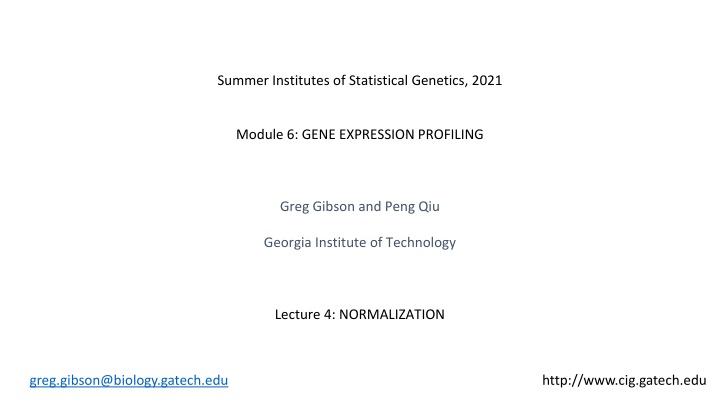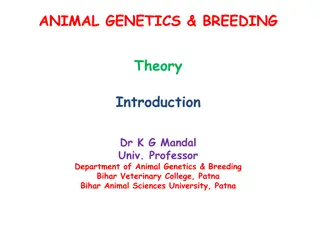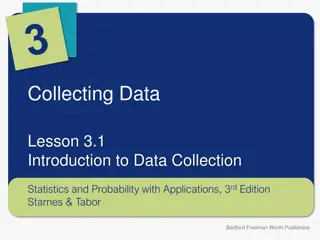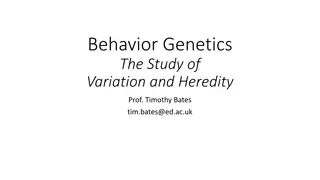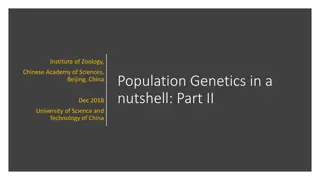Summer Institutes of Statistical Genetics, 2021
This comprehensive lecture discusses the importance of working on the log2 scale in gene expression profiling, explaining the benefits and practical applications of log transformation. It also delves into sample-specific normalization methods, emphasizing the transition from additive adjustments in microarray days to multiplicative scaling in RNAseq. Various approaches to normalization, such as mean or median transformation, variance transforms, quantile normalization, and gene-level model fitting, are explored in detail.
Download Presentation

Please find below an Image/Link to download the presentation.
The content on the website is provided AS IS for your information and personal use only. It may not be sold, licensed, or shared on other websites without obtaining consent from the author.If you encounter any issues during the download, it is possible that the publisher has removed the file from their server.
You are allowed to download the files provided on this website for personal or commercial use, subject to the condition that they are used lawfully. All files are the property of their respective owners.
The content on the website is provided AS IS for your information and personal use only. It may not be sold, licensed, or shared on other websites without obtaining consent from the author.
E N D
Presentation Transcript
Summer Institutes of Statistical Genetics, 2021 Module 6: GENE EXPRESSION PROFILING Greg Gibson and Peng Qiu Georgia Institute of Technology Lecture 4: NORMALIZATION greg.gibson@biology.gatech.edu http://www.cig.gatech.edu
Why do we work on the log2 scale ? 1. Log transformation makes the data more normally distributed, minimizing biases due to the common feature that a small number of genes account for over half the transcripts 2. Log base 2 is convenient, because in practice most differential expression is in the range of 1.2x to 8x, depending on the contrast of interest and complexity of the sample. 3. It is also intuitively simple to infer fold changes in a symmetrical manner: A difference of -1 unit corresponds to half the abundance, and +1 to twice the abundance A difference of -2 units corresponds to a quarter the abundance, and +3 to 8-times the abundance 4. The log scale is insensitive to mean centering, so it is simple to just set the mean or median to 0, preserving the relative abundance above or below the sample average 5. It is generally useful to add 1 to all values before taking the log, to avoid 0 returning #NUM! (but this step is built into most code, such as edgeR)
Sample-specific Normalization In the Microarray days, we generally used additive adjustment to center the mean or median When RNAseq took over, the emphasis shifted to multiplicative scaling to total counts Additional adjustments like TMM account for biases due to variable abundance of a small number of highly expressed transcripts, like HBB or Ribosomal or Mitochondrial components. If they account for 50% of the transcripts in one sample but 30% in another, then the CPM will all be higher on the second sample. Also for RNAseq data, adjustment is made for the high zero-count (drop-out) rate for low-abundance transcripts: the data is said to be negative binomially distributed. Limma/Voom estimate the actual distribution from the data and adjust expected variance estimates accordingly. Some analysts also adjust for GC content or gene length if they suspect a dependency of response to these.
Relative and Absolute Normalization Raw data: no effect Variance transformed: no effect Mean centered: significant effect
Approaches to Normalization Mean or Median transform, simply centers the distribution - Something like this is essential to control for overall distributional effects (eg RNA concentration) Variance transforms, such as standardization or inter-quartile range - Depends on whether you think the overall distributions should have similar variance Quantile normalization - Transforms the ranks to the average expression value for each rank Gene-level model fitting - Remove technical or biological effects before model fitting on the residuals Supervised normalization - Optimally estimate the biological effect while fitting technical factors across the entire experiment
Effect of Median Centering Raw Profiles Density Sample 6 7 8 9 10 11 12 Median Transform Density -2 -1 0 1 2 3 4 Sample For RNASeq data, CPM essentially does this: cpm = 1,000,000 x reads/total reads
Principal Component Variance Analysis It is always a good idea to start by asking what biological and technical factors dominate the variation in your samples. Then you can choose which ones to adjust for in your modeling.
Surrogate Variable Analysis COMBAT is a batch correction method: you remove the effects of technical confounders PEER factor analysis is a Bayesian approach that by default automatically adjusts for latent variables SVA (Surrogate Variable Analysis) gives you control over which variables to adjust for SNM (Supervised Normalization of Microarrays) iteratively adjusts for biological and technical factors
Normalization matters Raw vs Combat SVA vs Raw SVA vs Combat
Recommended Approach 1. Normalize the samples, paying attention to the distributions of overall profiles 2. Extract the Principal components of gene expression, and ask whether the major PC are correlated with technical covariates such as Batch or RNA quality; or with Biological variables of interest 3. If they are, renormalize to remove those effects 4. (i) (ii) gain insight into what may cause differences, eg find confounding factors As much as possible, analyze the dataset in several different ways to confirm that the findings are not sensitive to your analytical choice, and 5. Compare the final p-value distributions, and perform gene ontology analysis to evaluate which strategy is giving you biologically plausible insight.
